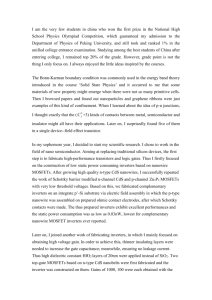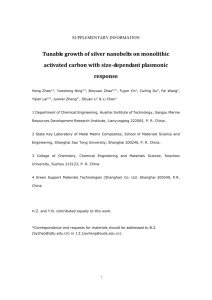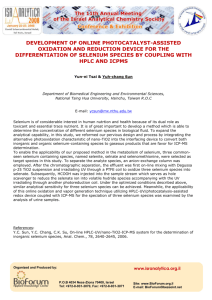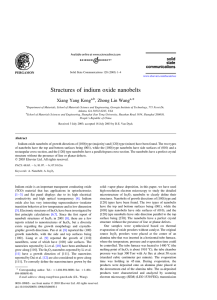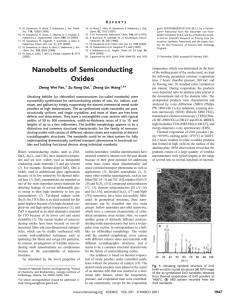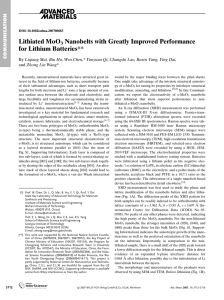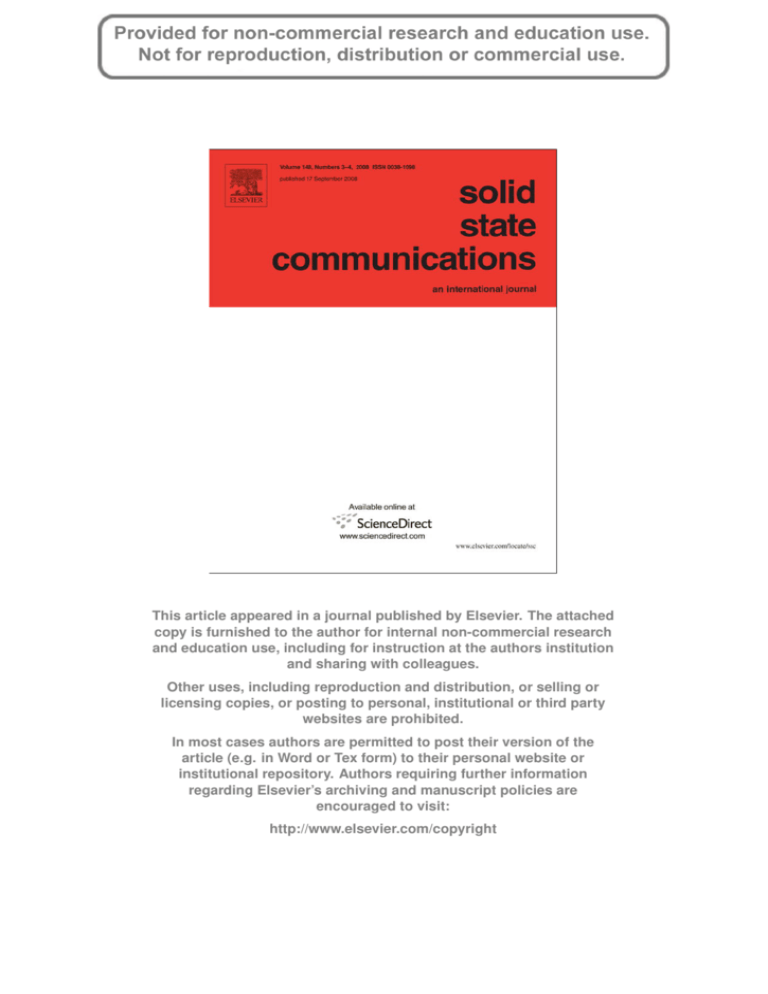
This article appeared in a journal published by Elsevier. The attached
copy is furnished to the author for internal non-commercial research
and education use, including for instruction at the authors institution
and sharing with colleagues.
Other uses, including reproduction and distribution, or selling or
licensing copies, or posting to personal, institutional or third party
websites are prohibited.
In most cases authors are permitted to post their version of the
article (e.g. in Word or Tex form) to their personal website or
institutional repository. Authors requiring further information
regarding Elsevier’s archiving and manuscript policies are
encouraged to visit:
http://www.elsevier.com/copyright
Author's personal copy
Solid State Communications 148 (2008) 145–147
Contents lists available at ScienceDirect
Solid State Communications
journal homepage: www.elsevier.com/locate/ssc
Rapid photoresponse of single-crystalline selenium nanobelts
Aimiao Qin a,b , Zhou Li b,c , Rusen Yang b , Yudong Gu b,c , Yuzi Liu b , Zhong Lin Wang b,∗
a
Key Laboratory of New Processing Technology for Nonferrous Metals and Materials, Ministry of Education, Department of Materials and Chemistry Engineering, Guilin Institute of
Technology, Guilin, 541004, China
b
School of Materials Science and Engineering, Georgia Institute of Technology, Atlanta, GA 30332, USA
c
Department of Advanced Materials and Nanotechnology, College of Engineering, Peking University, Beijing, 100871, China
article
info
Article history:
Received 1 July 2008
Accepted 20 July 2008 by A.H. MacDonald
Available online 26 July 2008
PACS:
72.40.+w
a b s t r a c t
Rapid photon response is demonstrated for devices made using individual single-crystalline selenium
nanobelts. The temperature dependence of the photocurrent has been studied between — 70 to 100 ◦ C.
The best performance is at temperatures below 40 ◦ C. The response time to fluorescent light is as quick
as 30 ms once tunes on, and the recovery time is as short as 50 ms when the light is off. This study
demonstrates the potential application of Se nanobelts for building fast photon detectors.
© 2008 Elsevier Ltd. All rights reserved.
Keywords:
A. Nanobelt
A. Se
D. Photoconductivity
1. Introduction
2. Experiment
In the past decade, one-dimensional (1-D) nanostructures such
as rods, wires, belts, ribbons and tubes have become the focus of intensive research owing to their fascinating applications
in mesoscopic physics and nanodevices. Selenium, as an important elemental semiconductor, is widely used in photocells,
photographic exposure meters, xerography, pressure sensors and
electrical rectifier due to its high photoconductivity and large
piezoelectric, thermoelectric and nonlinear responses [1–7]. On
the photoconductivity of selenium, most previous research has
mainly focused on amorphous selenium and hexagonal metallic selenium film or bulk materials. Recently, much work has been concentrated on the synthesis of 1-D selenium nanostructures such as
nanowires [8,9], nanorods [10], nanotubes [11], nanoribbons [12]
and nanobelts [13]. However, there is limited study available on
the physical properties of the Se nanostructures, especially as photonic or electrical devices [14]. Here we report a study about ultrafast photon response of trigonal selenium nanobelts fabricated by
a facile and large – scale synthesis method. The devices made using
individual nanobelts have a fast response to visible light illumination, with potential as fast photon sensors and photo-cells.
All of chemicals used for the synthesis were of analytical
grade and used as received without further purification. Singlecrystalline t-Se nanobelts were synthesized by solventhermal
method. A typical experimental procedure is described as following. 1.3 mmol (0.1g) Se and 17 ml ethanol were loaded into Teflonlined autoclave of 25 mL capacity. The autoclave was sealed and
maintained at 200 ◦ C for 24 h. Then the autoclave was taken
out and cooled to room temperature, the precipitates were filtered off and washed with absolute alcohol for several times and
dried naturally.
The as-synthesized products were characterized and analyzed
by X-Ray Diffraction (XRD, Alpha-1) using CuKa radiation, Field
Emission Scanning Electron Microscope (FE-SEM, Leon 1530)
equipped with an Energy Dispersive X-Ray Spectroscopy (EDX) and
transmission electron microscopy (TEM, HF-2000).
Electrical transport measurement was conducted based on devices made using single nanobelts. A single selenium nanobelt was
aligned on glass slide or thermally grown silicon oxide substrate
with cleaned surfaces. The electrical contacts were prepared by applying highly conductive silver paint through suitable masks. This
is possible because the nanobelts are rather long.
3. Results and discussion
∗
Corresponding author. Tel.: +1 4048948008; fax: +1 4048948008.
E-mail address: zlwang@gatech.edu (Z.L. Wang).
0038-1098/$ – see front matter © 2008 Elsevier Ltd. All rights reserved.
doi:10.1016/j.ssc.2008.07.039
Fig. 1(a, b) show low-magnification and high-magnification
scanning electron microscopy images of the t-Se nanobelts.
Author's personal copy
146
A. Qin et al. / Solid State Communications 148 (2008) 145–147
Fig. 1. (a) and (b) SEM images of single-crystalline Se nanobelts grown by a solventhermal method (c) XRD pattern of Se nanobelts confirms the trigonal structure, (d) EDS
of Se nanobelts shows the pure composition.
Fig. 2. Electron diffraction pattern and HRTEM of a typical Se nanobelt. (c) HRTEM image taken from the middle of the Se nanobelt (a) with growth direction [001], showing
its single-crystalline structure.The corresponding electron diffraction pattern (b) was obtained from the same Se nanostructure.
The nanobelt sizes range from 100 to 500 nm and lengths range
from tens to hundreds of micrometers. XRD from the sample
confirms the structure is trigonal (Fig. 1(c)). Chemical analysis
using energy-dispersixe X-ray spectroscopy (EDS) shows the pure
composition of Se (Fig. 1(d)). Transmission electron microscopy
(TEM) study (Fig. 2) further confirms that the t-Se nanobelts have
single-crystal structure with growth direction [001].
The photoconductivity measurements were first performed
using room light (fluorescent lamp) at room temperature at
ambient pressure. In order to investigate the temperature effect
on the photon sensitivity, we have carried out experiments at
different temperatures, and the results are presented in Fig. 3(a).
Under an applied voltage of 1 V, it is observed that the current
transported through a single nanowire drastically increases by a
factor of 10 when the light was turned on. The photoconductivity
is mainly determined by the recombination and trapping of
the electron-hole pairs within a solid material, and the rate
of such a recombination and trapping for selenium has been
shown to strongly depend on temperature [15,16]. In general, the
conductivity increases as temperature rises. Generally, trigonal
selenium is accepted as a p-type extrinsic semiconductor, and
conduction occurs due to valence band hole transport [16].
The increased thermal conductivity is likely due to the thermal
excitation of the electron-hole pairs in the valence band as
governed by exp(−Eg /KT ), where E = 1.6 eV (770 nm) is the
bandgap of Se, K is Boltzman constant and T is temperature.
The photosensitivity, defined as S = (I − Io )/Io , where I and
Io are the currents measured when the light is on and off,
respectively, is strongly affected by temperature. S drops as
temperature increases (Fig. 3(b)). The best photosensitivity is
received at temperatures lower than 40 ◦ C. The carriers are
contributed by thermal excitation and photon excitation. With the
increase of temperature, the thermal excitation is enhanced, thus,
the photosensitivity is relatively reduced.
The response time of the Se nanobelt to visible light is
characterized by the rising and falling shape of the photocurrent
curve. Fig. 4(a) and (b) show the sensitivity response to light at
room temperature, the increasing and the decay response times
are about 30 and 50 ms, respectively, as measured at the half
maximum.
In order to investigate the photon sensitivity of the t-Se
nanobelt to light of different wave lengths, the photocurrent
is measured with a chopped light (75 Watt xenon lamp) of
wavelengths selected in the range from 300 to 800 nm. It is found
Author's personal copy
A. Qin et al. / Solid State Communications 148 (2008) 145–147
147
Fig. 3. Temperature dependence of (a) photocoductivity and (b) photosensitivity of a Se nanobelt based device.
Fig. 4. (a) Response and (b) recovery of a Se nanobelt based device when a fluorescent light was turned on and off, respectively, at room temperature.
that the higher response is observed in the visible wavelength
range, which is in agreement with the previous report [4].
However, monochromatic light of 350 nm has a faster response
(0.140 s for light on and 0.2 s for light off) than that of 550
nm (0.185 and 0.229 s) and 650 nm (0.186 and 0.238 s) light.
The fluorescent lamp exhibit the quickest response (0.03 s and
0.05 s). According to the reference, the fluorescent lamp has
higher photoconductivity and faster response speed could be
attributed to a broader spectral overlap of the source with
the region of maximum photoconductive response of t-Se. The
maximum photoconductive response for our single- crystalline
t-Se nanobelt is at ∼550 nm, which is a little different from
that previously reported of 650 nm at −190 ◦ C and 750 nm
at 20 ◦ C [17].
4. Conclusion
In summary, rapid photon response and high photon sensitivity of single-crystalline Se nanobelt have been observed. The responses of Se nanobelt to fluorescent light at 25 ◦ C are 30 and 50
ms when the light is turned on and off, respectively. The highest
photon sensitivity is obtained at low temperatures. This study
demonstrates the potential of using Se nanobelts as rapid response
photo-sensors and photo-cells.
Acknowledgements
This work was supported under the NSF of Guangxi Zhuang
Autonomous Region (0640068), the Science Foundation of Guangxi
Education (200508043), USA DOE BES (DE-FG02-07ER46394) and
NSF (DMS 0706436).
References
[1] J.A. Johnson, L.M. Saboungi, D.J. Meisel, J. Phys. Chem. B 103 (1999) 59.
[2] R.A. Zingaro, W.C. Cooper (Eds.), Selenium, Van Nostrand Rainhold, New York,
1974.
[3] L.I. Berger, Semiconducting Materials, CRC Press, Boca Raton, FL, 1997.
[4] B. Gates, B. Mayers, A. Grossman, Y. Xia, Adv. Mater. 14 (2002) 1749.
[5] B. Gates, B. Mayers, B. Cattle, Y. Xia, Adv. Funct. Mater. 12 (2002) 219.
[6] H.T. Li, P.J. Regensburger, J. Appl. Phys. 34 (1963) 1730.
[7] U.K. Gautam, M. Nath, C.N.R. Rao, J. Mater. Chem. 13 (2003) 2845.
[8] B. Mayers, K. Liu, D. Sunderland, Y. Xia, Chem. Mater. 15 (2003) 3852.
[9] B. Gates, B. Mayers, B. Cattle, Y. Xia, Adv. Funct. Mater. 12 (2002) 219.
[10] J.M. Song, J.H. Zhu, S.H. Yu, J. Phys. Chem.B 110 (2006) 23790.
[11] Y.R. Ma, L. Qi, J. Ma, H. Cheng, Adv. Mater. 16 (2004) 1023.
[12] X. Cao, Y. Xie, S. Zhang, F. Li, Adv. Mater. 16 (2004) 649.
[13] Q. Wang, G.D. Li, Y.L. Liu, S. Xu, K.J. Wang, J.S. Chen, J. Phys. Chem. C 111 (2007)
12926.
[14] P. Liu, Y. Ma, W. Cai, Z. Wang, J. Wang, L. Qi, D. Chen, Nanotechnology 18 (2007)
205704.
[15] W.E. Spear, J. Phys. Chem. Solids 21 (1961) 110.
[16] M.A. Gilleo, J. Chem. Phys. 19 (1951) 1291.
[17] D.S. Elliott, Phys. Rev. 5 (1915) 53.


